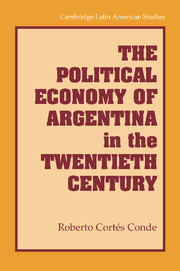Book contents
- Frontmatter
- Contents
- Acronyms
- Acknowledgments
- Introduction
- 1 Period of Rapid Economic Expansion: 1880–1914
- 2 From World War I to the Great Depression of 1930
- 3 From the 1930 Financial Crisis to World War II
- 4 The Political Economy of Peronism
- 5 A Divided Society, 1955–1973
- 6 The Long Decline
- Epilogue
- Statistical Appendix
- Bibliography
- Index
- Titles in the series
- References
1 - Period of Rapid Economic Expansion: 1880–1914
Published online by Cambridge University Press: 28 August 2009
- Frontmatter
- Contents
- Acronyms
- Acknowledgments
- Introduction
- 1 Period of Rapid Economic Expansion: 1880–1914
- 2 From World War I to the Great Depression of 1930
- 3 From the 1930 Financial Crisis to World War II
- 4 The Political Economy of Peronism
- 5 A Divided Society, 1955–1973
- 6 The Long Decline
- Epilogue
- Statistical Appendix
- Bibliography
- Index
- Titles in the series
- References
Summary
The 1880s were characterized by intense economic activity. The bustling Port of Buenos Aires epitomizes this decade, with the arrival of ships packed with goods and immigrants from a panoply of nations. These ships left Buenos Aires filled with raw wool, hides, and later, grains. Argentine goods poured into European ports, but European goods returning to Argentina occupied less space. So the unused cargo space on these ships was filled with human cargo. This became an inexpensive way for European immigrants to reach Argentina, where the rapidly growing economy held the promise of work, either in agriculture or in urban centers.
Europeans became a significant part of Argentina's population. Although a majority of the new immigrants identified themselves as farmers, during the 1880s the railroad had not yet reached the interior, so the European immigrants remained in Buenos Aires and in other costal cities where the dizzying pace of investment created an insatiable need for labor. In the Argentine Pampas, without navigable rivers – except the Paraná – the development of agriculture would have to wait for the construction of the railroad, the cost of which was well beyond Argentina's saving capacity. Thus, when it took on the project, the government financed railroad construction by accruing external debt. When private investment was allowed to enter the picture, it was through concessions to foreign companies that were guaranteed profits.
- Type
- Chapter
- Information
- Publisher: Cambridge University PressPrint publication year: 2008



